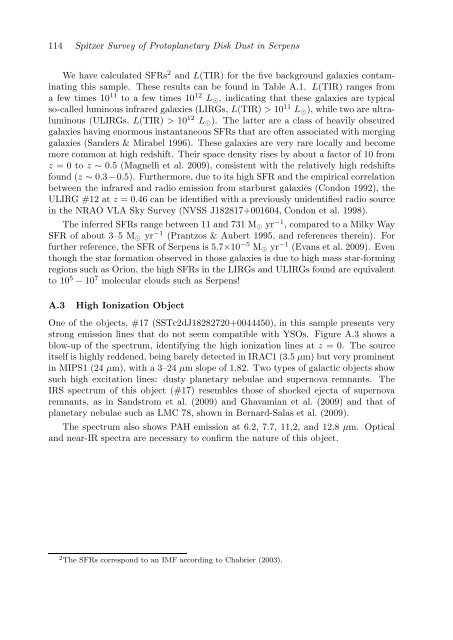Observational Constraints on The Evolution of Dust in ...
Observational Constraints on The Evolution of Dust in ...
Observational Constraints on The Evolution of Dust in ...
Create successful ePaper yourself
Turn your PDF publications into a flip-book with our unique Google optimized e-Paper software.
114 Spitzer Survey <strong>of</strong> Protoplanetary Disk <strong>Dust</strong> <strong>in</strong> Serpens<br />
We have calculated SFRs 2 and L(TIR) for the five background galaxies c<strong>on</strong>tam<strong>in</strong>at<strong>in</strong>g<br />
this sample. <strong>The</strong>se results can be found <strong>in</strong> Table A.1. L(TIR) ranges from<br />
a few times 10 11 to a few times 10 12 L ⊙ , <strong>in</strong>dicat<strong>in</strong>g that these galaxies are typical<br />
so-called lum<strong>in</strong>ous <strong>in</strong>frared galaxies (LIRGs, L(TIR) > 10 11 L ⊙ ), while two are ultralum<strong>in</strong>ous<br />
(ULIRGs, L(TIR) > 10 12 L ⊙ ). <strong>The</strong> latter are a class <strong>of</strong> heavily obscured<br />
galaxies hav<strong>in</strong>g enormous <strong>in</strong>stantaneous SFRs that are <strong>of</strong>ten associated with merg<strong>in</strong>g<br />
galaxies (Sanders & Mirabel 1996). <strong>The</strong>se galaxies are very rare locally and become<br />
more comm<strong>on</strong> at high redshift. <strong>The</strong>ir space density rises by about a factor <strong>of</strong> 10 from<br />
z = 0 to z ∼ 0.5 (Magnelli et al. 2009), c<strong>on</strong>sistent with the relatively high redshifts<br />
found (z ∼ 0.3 −0.5). Furthermore, due to its high SFR and the empirical correlati<strong>on</strong><br />
between the <strong>in</strong>frared and radio emissi<strong>on</strong> from starburst galaxies (C<strong>on</strong>d<strong>on</strong> 1992), the<br />
ULIRG #12 at z = 0.46 can be identified with a previously unidentified radio source<br />
<strong>in</strong> the NRAO VLA Sky Survey (NVSS J182817+001604, C<strong>on</strong>d<strong>on</strong> et al. 1998).<br />
<strong>The</strong> <strong>in</strong>ferred SFRs range between 11 and 731 M ⊙ yr −1 , compared to a Milky Way<br />
SFR <strong>of</strong> about 3–5 M ⊙ yr −1 (Prantzos & Aubert 1995, and references there<strong>in</strong>). For<br />
further reference, the SFR <strong>of</strong> Serpens is 5.7×10 −5 M ⊙ yr −1 (Evans et al. 2009). Even<br />
though the star formati<strong>on</strong> observed <strong>in</strong> those galaxies is due to high mass star-form<strong>in</strong>g<br />
regi<strong>on</strong>s such as Ori<strong>on</strong>, the high SFRs <strong>in</strong> the LIRGs and ULIRGs found are equivalent<br />
to 10 5 − 10 7 molecular clouds such as Serpens!<br />
A.3 High I<strong>on</strong>izati<strong>on</strong> Object<br />
One <strong>of</strong> the objects, #17 (SSTc2dJ18282720+0044450), <strong>in</strong> this sample presents very<br />
str<strong>on</strong>g emissi<strong>on</strong> l<strong>in</strong>es that do not seem compatible with YSOs. Figure A.3 shows a<br />
blow-up <strong>of</strong> the spectrum, identify<strong>in</strong>g the high i<strong>on</strong>izati<strong>on</strong> l<strong>in</strong>es at z = 0. <strong>The</strong> source<br />
itself is highly reddened, be<strong>in</strong>g barely detected <strong>in</strong> IRAC1 (3.5 µm) but very prom<strong>in</strong>ent<br />
<strong>in</strong> MIPS1 (24 µm), with a 3–24 µm slope <strong>of</strong> 1.82. Two types <strong>of</strong> galactic objects show<br />
such high excitati<strong>on</strong> l<strong>in</strong>es: dusty planetary nebulae and supernova remnants. <strong>The</strong><br />
IRS spectrum <strong>of</strong> this object (#17) resembles those <strong>of</strong> shocked ejecta <strong>of</strong> supernova<br />
remnants, as <strong>in</strong> Sandstrom et al. (2009) and Ghavamian et al. (2009) and that <strong>of</strong><br />
planetary nebulae such as LMC 78, shown <strong>in</strong> Bernard-Salas et al. (2009).<br />
<strong>The</strong> spectrum also shows PAH emissi<strong>on</strong> at 6.2, 7.7, 11.2, and 12.8 µm. Optical<br />
and near-IR spectra are necessary to c<strong>on</strong>firm the nature <strong>of</strong> this object.<br />
2 <strong>The</strong> SFRs corresp<strong>on</strong>d to an IMF accord<strong>in</strong>g to Chabrier (2003).
















